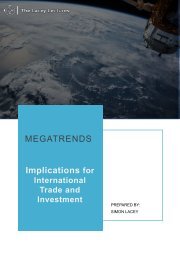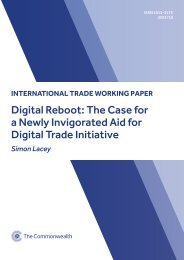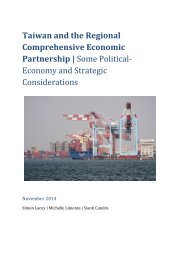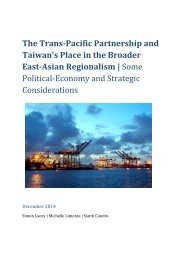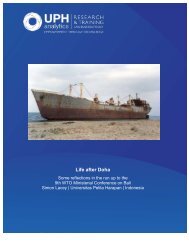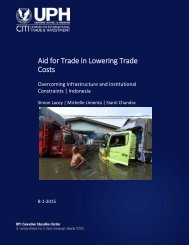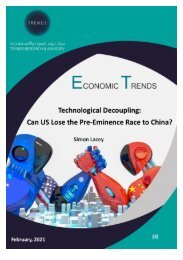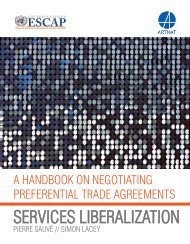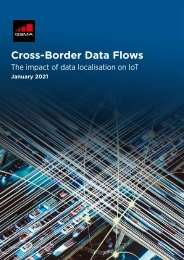Negotiating Strategies for LDCs to Make the Most of Aid for Trade
This is the second of two papers I wrote for the United Nations Economic and Social Committee for Asia and the Pacific (UNESCAP) in early 2020. This paper discusses why least developed countries, who are traditionally reluctant to engage in trade negotiations because of a lack of offensive market access interests, need to get more serious about joining these talks and leveraging their participation to extract valuable Aid for Trade concessions from their developed country counterparts.
This is the second of two papers I wrote for the United Nations Economic and Social Committee for Asia and the Pacific (UNESCAP) in early 2020. This paper discusses why least developed countries, who are traditionally reluctant to engage in trade negotiations because of a lack of offensive market access interests, need to get more serious about joining these talks and leveraging their participation to extract valuable Aid for Trade concessions from their developed country counterparts.
Create successful ePaper yourself
Turn your PDF publications into a flip-book with our unique Google optimized e-Paper software.
5<br />
<strong>Negotiating</strong> strategies <strong>for</strong><br />
<strong>LDCs</strong> <strong>to</strong> make <strong>the</strong> most <strong>of</strong><br />
<strong>Aid</strong> <strong>for</strong> <strong>Trade</strong><br />
Simon Lacey<br />
ASIA-PACIFIC RESEARCH AND TRAINING NETWORK ON TRADE<br />
Working Paper<br />
No. 195 | 2020
The Asia-Pacific Research and Training Network on <strong>Trade</strong> (ARTNeT) is an open<br />
regional network <strong>of</strong> research and academic institutions specializing in international<br />
trade policy and facilitation issues. ESCAP, WTO and UNCTAD, as key core network<br />
partners, and a number <strong>of</strong> bilateral development partners, provide substantive and/or<br />
financial support <strong>to</strong> <strong>the</strong> network. The <strong>Trade</strong>, Investment and Innovation Division <strong>of</strong><br />
ESCAP, <strong>the</strong> regional branch <strong>of</strong> <strong>the</strong> United Nations <strong>for</strong> Asia and <strong>the</strong> Pacific, provides<br />
<strong>the</strong> Secretariat <strong>of</strong> <strong>the</strong> network and a direct regional link <strong>to</strong> trade policymakers and<br />
o<strong>the</strong>r international organizations.<br />
The ARTNeT Working Paper Series disseminates <strong>the</strong> findings <strong>of</strong> work in progress <strong>to</strong><br />
encourage <strong>the</strong> exchange <strong>of</strong> ideas about trade issues. An objective <strong>of</strong> <strong>the</strong> series is <strong>to</strong><br />
publish <strong>the</strong> findings quickly, even if <strong>the</strong> presentations are less than fully polished.<br />
ARTNeT Working Papers are available online at artnet.unescap.org. All material in<br />
<strong>the</strong> Working Papers may be freely quoted or reprinted, but acknowledgment is<br />
requested <strong>to</strong>ge<strong>the</strong>r with a copy <strong>of</strong> <strong>the</strong> publication containing <strong>the</strong> quotation or reprint.<br />
The use <strong>of</strong> <strong>the</strong> Working Papers <strong>for</strong> any commercial purpose, including resale, is<br />
prohibited.<br />
Disclaimer:<br />
The designations employed and <strong>the</strong> presentation <strong>of</strong> <strong>the</strong> material in this Working<br />
Paper do not imply <strong>the</strong> expression <strong>of</strong> any opinion whatsoever on <strong>the</strong> part <strong>of</strong> <strong>the</strong><br />
Secretariat <strong>of</strong> <strong>the</strong> United Nations concerning <strong>the</strong> legal status <strong>of</strong> any country, terri<strong>to</strong>ry,<br />
city or area, or <strong>of</strong> its authorities, or concerning <strong>the</strong> delimitation <strong>of</strong> its frontiers or<br />
boundaries. Where <strong>the</strong> designation “country or area” appears, it covers countries,<br />
terri<strong>to</strong>ries, cities or areas. Bibliographical and o<strong>the</strong>r references have, wherever<br />
possible, been verified. The United Nations bears no responsibility <strong>for</strong> <strong>the</strong> availability<br />
or functioning <strong>of</strong> URLs. The views expressed in this publication are those <strong>of</strong> <strong>the</strong><br />
author(s) and do not necessarily reflect <strong>the</strong> views <strong>of</strong> <strong>the</strong> United Nations. The<br />
opinions, figures and estimates set <strong>for</strong>th in this publication are <strong>the</strong> responsibility <strong>of</strong><br />
<strong>the</strong> author(s) and should not necessarily be considered as reflecting <strong>the</strong> views or<br />
carrying <strong>the</strong> endorsement <strong>of</strong> <strong>the</strong> United Nations. Any errors are <strong>the</strong> responsibility <strong>of</strong><br />
<strong>the</strong> author(s). The mention <strong>of</strong> firm names and commercial products does not imply<br />
<strong>the</strong> endorsement <strong>of</strong> <strong>the</strong> United Nations.<br />
© ARTNeT 2020
ASIA-PACIFIC RESEARCH AND TRAINING NETWORK ON TRADE<br />
WORKING PAPER<br />
<strong>Negotiating</strong> strategies <strong>for</strong> <strong>LDCs</strong> <strong>to</strong> make <strong>the</strong> most <strong>of</strong> <strong>Aid</strong> <strong>for</strong> <strong>Trade</strong><br />
Simon Lacey 1<br />
Please cite this paper as:<br />
Lacey, Simon (2020). “<strong>Negotiating</strong> strategies <strong>for</strong> <strong>LDCs</strong> <strong>to</strong> make <strong>the</strong> most <strong>of</strong> <strong>Aid</strong> <strong>for</strong><br />
<strong>Trade</strong>”, ARTNeT Working Paper Series No. 195, July 2020, Bangkok ESCAP<br />
Available at https://artnet.unescap.org<br />
1 Senior Lecturer in International <strong>Trade</strong> at <strong>the</strong> University <strong>of</strong> Adelaide, Australia, e-mail:<br />
simon.lacey@adelaide.edu.au. This paper is one <strong>of</strong> <strong>the</strong> outputs under <strong>the</strong> project titled “Streng<strong>the</strong>ning<br />
capacity <strong>of</strong> ESCAP member States <strong>to</strong> utilize trade as a means <strong>of</strong> implementation <strong>for</strong> sustainable<br />
development” funded from ESCAP’s Regular Programme <strong>of</strong> Technical Cooperation. The author is<br />
grateful <strong>to</strong> Mia Mikic <strong>for</strong> comments and <strong>to</strong> Nicolas Zang <strong>for</strong> editing assistance as well as <strong>to</strong> <strong>the</strong> ARTNeT<br />
secretariat <strong>for</strong> <strong>the</strong> technical support in preparing this paper <strong>for</strong> dissemination.<br />
i
Abstract<br />
This paper explores <strong>the</strong> kinds <strong>of</strong> demands governments in Least Developed Countries<br />
(<strong>LDCs</strong>) could and should be <strong>for</strong>mulating and submitting in <strong>the</strong> context <strong>of</strong> <strong>the</strong> e-<br />
commerce negotiations at <strong>the</strong> World <strong>Trade</strong> Organisation (WTO) as well as any current<br />
or proposed Free <strong>Trade</strong> Agreements (FTAs) <strong>the</strong>y are engaged in with advanced<br />
industrialized countries.<br />
It begins by discussing <strong>the</strong> differences between Special and Differential Treatment<br />
(S&D) and <strong>Aid</strong> <strong>for</strong> <strong>Trade</strong> (AfT) and affirms that in <strong>to</strong>day’s environment, developing<br />
countries and <strong>LDCs</strong> should never miss an opportunity <strong>to</strong> engage in trade negotiations<br />
with more economically advanced trading partners, since even if limited market access<br />
gains are on <strong>of</strong>fer, <strong>the</strong> prospect <strong>of</strong> obtaining o<strong>the</strong>r concessions in different parts <strong>of</strong> <strong>the</strong><br />
AfT agenda could still make <strong>for</strong> tangible and significant negotiating outcomes <strong>for</strong> <strong>the</strong>se<br />
countries.<br />
This paper focuses on negotiating strategies with respect <strong>to</strong> two kinds <strong>of</strong> broadly<br />
<strong>for</strong>mulated AfT commitments. The first is infrastructure <strong>to</strong> alleviate supply-side<br />
constraints across transport infrastructure, testing and certification capacity and<br />
communications network infrastructure <strong>for</strong> online connectivity. The second set <strong>of</strong> AfT<br />
commitments this paper seeks <strong>to</strong> provide developing country negotia<strong>to</strong>rs advice on is<br />
in <strong>the</strong> area <strong>of</strong> trade finance, which has become such a prevalent problem <strong>for</strong> small and<br />
medium-sized enterprises (SMEs) in developing countries that even <strong>the</strong> WTO<br />
Secretariat has started <strong>to</strong> refer <strong>to</strong> this as a non-tariff measure.<br />
As in all negotiations, <strong>the</strong> key <strong>to</strong> success here is preparation. This paper provides some<br />
advice on how best <strong>to</strong> prepare, <strong>for</strong>mulate and substantiate any AfT requests in order<br />
<strong>to</strong> both maximize <strong>the</strong> chance <strong>of</strong> success as well as maximize <strong>the</strong> difficulty <strong>for</strong><br />
negotia<strong>to</strong>rs from developed countries (who must decide on whe<strong>the</strong>r <strong>to</strong> grant an AfT<br />
request) <strong>to</strong> decline any reasonable requests that are tabled.<br />
Keywords: <strong>Trade</strong> and development, <strong>Aid</strong>-<strong>for</strong>-<strong>Trade</strong>, Negotiations, Least Developed<br />
Countries<br />
JEL Codes: F02, O19, O24<br />
ii
Contents<br />
1 Introduction ..................................................................................... 1<br />
1.1 Special and Differential Treatment and <strong>Aid</strong> <strong>for</strong> <strong>Trade</strong> .............................. 1<br />
1.2 The future <strong>of</strong> AfT as <strong>the</strong> best <strong>to</strong>ol in <strong>the</strong> <strong>to</strong>olbox ...................................... 3<br />
1.3 AfT commitments <strong>to</strong> address trade infrastructure bottlenecks .............. 4<br />
1.4 AfT commitments <strong>for</strong> trade finance ........................................................... 4<br />
2 <strong>Aid</strong> <strong>for</strong> <strong>Trade</strong> and infrastructure .................................................... 4<br />
2.1 Transport infrastructure ............................................................................. 5<br />
2.2 Testing and certification infrastructure ..................................................... 6<br />
2.3 In<strong>for</strong>mation and communications network infrastructure ....................... 7<br />
3 <strong>Aid</strong> <strong>for</strong> <strong>Trade</strong> finance ...................................................................... 9<br />
3.1 The trade finance gap ................................................................................. 9<br />
3.2 Donor-funded technical assistance ......................................................... 10<br />
3.3 Framing <strong>Aid</strong> <strong>for</strong> <strong>Trade</strong> finance requests .................................................. 11<br />
4 Conclusion and recommendations ................................................. 12<br />
List <strong>of</strong> references ............................................................................. 14<br />
iii
1 Introduction<br />
This paper explores <strong>the</strong> potential <strong>for</strong> trade negotia<strong>to</strong>rs in developing countries and<br />
<strong>LDCs</strong> <strong>to</strong> engage in ongoing negotiations happening <strong>for</strong> example on <strong>the</strong> side-lines <strong>of</strong><br />
<strong>the</strong> WTO on e-commerce, or in potential future negotiations on investment facilitation,<br />
and a number <strong>of</strong> ongoing FTAs, in order <strong>to</strong> extract <strong>the</strong> best possible set <strong>of</strong> concessions<br />
<strong>to</strong> advance <strong>the</strong>ir own development interests. It argues that <strong>the</strong> optimal strategy <strong>for</strong> trade<br />
negotia<strong>to</strong>rs in developing countries and <strong>LDCs</strong> is <strong>to</strong> engage whole-heartedly in <strong>the</strong>se<br />
talks, <strong>for</strong>mulate a carefully crafted set <strong>of</strong> demands and extract <strong>the</strong> best possible<br />
concessions from developed countries, who depend on <strong>the</strong> participation and<br />
acquiescence <strong>of</strong> developing countries and <strong>LDCs</strong> <strong>to</strong> af<strong>for</strong>d legitimacy <strong>to</strong> any negotiated<br />
outcomes.<br />
1.1 Special and Differential Treatment and <strong>Aid</strong> <strong>for</strong> <strong>Trade</strong><br />
In <strong>the</strong> context <strong>of</strong> <strong>the</strong> WTO, <strong>the</strong> term “Special and Differential Treatment” (S&D) refers<br />
<strong>to</strong> a set <strong>of</strong> preferential provisions and flexibilities that allow developing countries <strong>to</strong><br />
deviate from a number <strong>of</strong> <strong>the</strong> WTO’s core legal obligations and principles, such as<br />
<strong>Most</strong> Favoured Nation (MFN) or reciprocity (Tempone, 2014). These provisions and<br />
flexibilities have evolved over time as first General Agreement on Tariffs and <strong>Trade</strong><br />
(GATT) contracting parties and later WTO members grappled with <strong>the</strong> need <strong>to</strong> find<br />
ways <strong>to</strong> make <strong>the</strong> system <strong>of</strong> rules and disciplines that make up <strong>the</strong> multilateral trading<br />
system function in a way that provides more favourable outcomes <strong>to</strong> developing and<br />
least developed countries. According <strong>to</strong> a typology proposed by <strong>the</strong> WTO Secretariat,<br />
under <strong>the</strong> WTO agreements, S&D provisions can be divided in<strong>to</strong> six broad categories:<br />
(1) provisions aimed at increasing trade opportunities; (2) provisions that require WTO<br />
members <strong>to</strong> safeguard <strong>the</strong> interests <strong>of</strong> developing country members; (3) flexibility <strong>of</strong><br />
commitments; (4) transitional time periods; (5) technical assistance; and (6) differential<br />
and more favourable treatment <strong>of</strong> <strong>the</strong> least-developed countries (WTO, 1999)<br />
<strong>Aid</strong> <strong>for</strong> <strong>Trade</strong> (AfT) as a negotiating paradigm first entered <strong>the</strong> multilateral arena at <strong>the</strong><br />
6 th WTO Ministerial Conference, which <strong>to</strong>ok place in Hong Kong, China in December<br />
1
2005. 2 Today AfT is a catch-all phrase that encompasses all and any <strong>of</strong>ficial<br />
development assistance directed at improving <strong>the</strong> trade capacity <strong>of</strong> developing<br />
countries, helping <strong>the</strong>m <strong>to</strong> overcome supply-side constraints or improving developing<br />
countries' capacity <strong>to</strong> produce and export. The AfT Task Force 3 identifies six distinct<br />
categories <strong>of</strong> assistance, some <strong>of</strong> which will be discussed in more detail in this paper.<br />
They are <strong>the</strong> following:<br />
a) <strong>Trade</strong> policy and regulations: which includes training trade <strong>of</strong>ficials, helping<br />
governments implement trade agreements, and complying with rules and<br />
standards;<br />
b) <strong>Trade</strong> development: which includes providing support services <strong>for</strong> business,<br />
promoting finance and investment, conducting market analysis and e-<br />
commerce;<br />
c) <strong>Trade</strong>-related infrastructure: which includes building roads and ports and<br />
connectivity infrastructure such as telecommunications networks;<br />
d) Building productive capacity: improving <strong>the</strong> capacity <strong>of</strong> a country <strong>to</strong> produce<br />
goods and services;<br />
e) <strong>Trade</strong>-related adjustment: which includes financial assistance <strong>to</strong> meet<br />
adjustment costs from trade policy re<strong>for</strong>m, including balance <strong>of</strong> payment<br />
problems resulting from lost tariff revenues or from <strong>the</strong> erosion <strong>of</strong> preferential<br />
market access;<br />
f) O<strong>the</strong>r trade-related needs.<br />
The 2013 WTO <strong>Trade</strong> Facilitation Agreement (TFA) represented something <strong>of</strong> a<br />
watershed <strong>for</strong> <strong>the</strong> traditional concept <strong>of</strong> Special and Differential Treatment (SDT) and<br />
saw technical assistance commitments built in<strong>to</strong> <strong>the</strong> Agreement as part <strong>of</strong> quid-proquo<br />
that developed countries would provide <strong>to</strong> developing countries in order <strong>to</strong> support<br />
<strong>the</strong>m in moving <strong>to</strong>wards more comprehensive implementation <strong>of</strong> <strong>the</strong> trade facilitation<br />
commitments set out in <strong>the</strong> TFA.<br />
2<br />
See paragraph 57 <strong>of</strong> <strong>the</strong> WTO Ministerial Declaration adopted on 18 December 2005 in Hong Kong, China<br />
available at: https://www.w<strong>to</strong>.org/english/<strong>the</strong>w<strong>to</strong>_e/minist_e/min05_e/final_text_e.htm#aid_<strong>for</strong>_trade.<br />
3<br />
The Direc<strong>to</strong>r-General <strong>of</strong> <strong>the</strong> WTO announced <strong>the</strong> composition <strong>of</strong> <strong>the</strong> Task Force at <strong>the</strong> General Council meeting<br />
<strong>of</strong> 7 February 2006; <strong>the</strong> Task Force was charged with operationalizing <strong>Aid</strong>-For-<strong>Trade</strong>, and submitted its<br />
recommendations <strong>to</strong> <strong>the</strong> General Council on 27-28 July 2006; see:<br />
https://www.w<strong>to</strong>.org/english/tra<strong>to</strong>p_e/devel_e/a4t_e/implementing_par57_e.htm.<br />
2
1.2 The future <strong>of</strong> AfT as <strong>the</strong> best <strong>to</strong>ol in <strong>the</strong> <strong>to</strong>olbox<br />
For all intents and purposes, <strong>the</strong> Doha Development Agenda (DDA) can be assumed<br />
<strong>to</strong> be dead and buried, even though some WTO members resist this diagnosis. The<br />
failure <strong>to</strong> achieve a breakthrough in 2008 in Geneva, despite <strong>the</strong> best ef<strong>for</strong>ts <strong>of</strong> <strong>the</strong>n<br />
Direc<strong>to</strong>r General Pascal Lamy, are <strong>the</strong> closest <strong>the</strong> WTO came <strong>to</strong> concluding <strong>the</strong> round<br />
(Blustein, 2009). What happened at <strong>the</strong> 10 th WTO Ministerial Conference in Nairobi in<br />
2013 was an admission by <strong>the</strong> Organization that <strong>the</strong>re were strong disagreements<br />
among <strong>the</strong> membership as <strong>to</strong> what <strong>to</strong> do about <strong>the</strong> DDA, and in <strong>the</strong> absence <strong>of</strong> any<br />
consensus on continuing <strong>the</strong> round, negotiations would cease (Financial Times<br />
Edi<strong>to</strong>rial Board, 2015) 4 . Even though <strong>the</strong> DDA is effectively over, <strong>the</strong>re are o<strong>the</strong>r areas<br />
where negotiations are continuing, such as between a large group <strong>of</strong> interested<br />
members under <strong>the</strong> Joint Statement Initiative which may culminate in potential new<br />
rules on electronic commerce. There are also discussions being held in <strong>the</strong> WTO<br />
General Council on <strong>the</strong> utility <strong>of</strong> launching negotiations on investment facilitation. In<br />
addition <strong>to</strong> this, <strong>the</strong>re are various <strong>for</strong>a in which developing countries and leastdeveloped<br />
countries are joining negotiations on future market access commitments,<br />
as well as trade and investment rules with developed countries.<br />
<strong>Aid</strong> <strong>for</strong> <strong>Trade</strong> arguably now <strong>of</strong>fers one <strong>of</strong> <strong>the</strong> most effective instruments <strong>for</strong><br />
governments in developing countries and <strong>LDCs</strong> <strong>to</strong> engage with developed countries in<br />
<strong>the</strong> context <strong>of</strong> both sec<strong>to</strong>ral negotiations such as those on e-commerce on <strong>the</strong> one<br />
hand (and perhaps in future on investment facilitation) and FTAs on <strong>the</strong> o<strong>the</strong>r, in order<br />
<strong>to</strong> exchange limited and carefully sequenced liberalization concessions as a quid pro<br />
quo <strong>for</strong> targeted and well-thought-out AfT commitments. Policymakers in developing<br />
countries and <strong>LDCs</strong> need <strong>to</strong> consider carefully what AfT commitments <strong>to</strong> include in<br />
negotiating proposals and <strong>to</strong> ensure such proposals are supported by data, hard<br />
evidence and a track record <strong>of</strong> good-faith ef<strong>for</strong>ts at implementing domestic re<strong>for</strong>ms that<br />
can ensure maximum “bang <strong>for</strong> <strong>the</strong> AfT buck”.<br />
4<br />
See also paragraph 30 <strong>of</strong> <strong>the</strong> Ministerial Declaration adopted on 19 December 2015 in Nairobi, available at:<br />
https://www.w<strong>to</strong>.org/english/<strong>the</strong>w<strong>to</strong>_e/minist_e/mc10_e/mindecision_e.htm<br />
3
1.3 AfT commitments <strong>to</strong> address trade infrastructure bottlenecks<br />
Some <strong>of</strong> <strong>the</strong>se commitments need <strong>to</strong> address existing infrastructure constraints in<br />
terms <strong>of</strong> roads, ports, but also labora<strong>to</strong>ries <strong>for</strong> testing and certification <strong>of</strong> products <strong>for</strong><br />
con<strong>for</strong>mity with international standards, so <strong>the</strong>y can be exported <strong>to</strong> global markets. In<br />
<strong>the</strong> context <strong>of</strong> <strong>the</strong> e-commerce negotiations in particular, developing countries need <strong>to</strong><br />
think hard about advancing negotiating proposals that seek <strong>to</strong> address supply-side<br />
constraints in <strong>the</strong> area <strong>of</strong> communications network infrastructure (see Section 2 below<br />
<strong>for</strong> more on this).<br />
1.4 AfT commitments <strong>for</strong> trade finance<br />
<strong>Trade</strong> finance is consistently listed as one <strong>of</strong> <strong>the</strong> constraints limiting <strong>the</strong> ability <strong>of</strong> SMEs<br />
in developing countries and <strong>LDCs</strong> <strong>to</strong> export, and this is undoubtedly one area where<br />
AfT commitments can be directed <strong>to</strong> bridge <strong>the</strong> considerable gap that exists between<br />
<strong>the</strong> limited availability <strong>of</strong> trade finance and <strong>the</strong> huge demand from SMEs <strong>to</strong> obtain<br />
easier access <strong>to</strong> this instrument. These commitments should be sought as a quid pro<br />
quo <strong>for</strong> any liberalization concessions <strong>of</strong>fered in <strong>the</strong> context <strong>of</strong> <strong>the</strong> Joint Statement<br />
Initiative e-commerce negotiations at <strong>the</strong> WTO, but also <strong>for</strong> any similar concessions<br />
<strong>of</strong>fered in FTA negotiations (see Section 3 <strong>of</strong> this paper <strong>for</strong> fur<strong>the</strong>r explanation on this).<br />
The following two sections <strong>of</strong> this paper focus on <strong>the</strong>se two areas specifically<br />
(infrastructure and trade finance) where <strong>of</strong>ficials from developing countries and <strong>LDCs</strong><br />
need <strong>to</strong> carefully consider <strong>the</strong> kinds <strong>of</strong> requests <strong>the</strong>y table in trade negotiations with<br />
<strong>the</strong>ir developed-country counterparts.<br />
2 <strong>Aid</strong> <strong>for</strong> <strong>Trade</strong> and infrastructure<br />
This section discusses <strong>the</strong> importance <strong>of</strong> infrastructure in overcoming supply-side<br />
constraints <strong>to</strong> connecting with global value chains, in particular in <strong>the</strong> area <strong>of</strong> transport,<br />
quality infrastructure and communications networks. It finds that many donor agencies<br />
have an established track-record in this space and that developing country <strong>of</strong>ficials<br />
should be able <strong>to</strong> achieve a measure <strong>of</strong> success in securing commitments from <strong>the</strong>ir<br />
developed country counterparts in <strong>the</strong> context <strong>of</strong> trade negotiations if any AfT requests<br />
tabled are accompanied by sufficient supporting economic data and analysis.<br />
4
2.1 Transport infrastructure<br />
The role <strong>of</strong> adequate transport infrastructure in addressing supply-side constraints <strong>to</strong><br />
trade is well documented (Nordås and Piermartini, 2004). Road and rail networks play<br />
an important role in not only moving goods but also people, <strong>the</strong>reby connecting poorer<br />
rural areas with more productive urban centers. The linkages between adequate<br />
connectivity, low logistics costs and economic competitiveness are likewise well<br />
established and are increasingly being cited in <strong>the</strong> growing literature on global value<br />
chains (Neilson, Pritchard and Wai-Chung, 2014). Donor-funded support <strong>for</strong> transport<br />
infrastructure under <strong>the</strong> AfT initiative have been an important focus <strong>for</strong> many donors<br />
since <strong>the</strong> launch <strong>of</strong> AfT (Sheperd, 2013). There is adequate funding <strong>to</strong> address <strong>the</strong>se<br />
kinds <strong>of</strong> constraints by multilateral agencies such as <strong>the</strong> Asian Development Bank, or<br />
<strong>the</strong> Asian Infrastructure Investment Bank, which provide concessional loans in support<br />
<strong>of</strong> road infrastructure projects in many countries throughout <strong>the</strong> region.<br />
As <strong>the</strong> 2019 edition <strong>of</strong> <strong>the</strong> bi-annual joint Organisation <strong>for</strong> Economic Co-Operation and<br />
Development (OECD)/WTO publication <strong>Aid</strong> <strong>for</strong> <strong>Trade</strong> at a Glance points out, <strong>the</strong><br />
importance <strong>of</strong> transport (and logistics) infrastructure in alleviating supply-side<br />
constraints in developing countries is well-recognized by <strong>the</strong> donor community, so that<br />
in 2017, some 50% <strong>of</strong> Official Development Assistance (ODA) commitments <strong>to</strong> trade<br />
related infrastructure went <strong>to</strong> fund transport and s<strong>to</strong>rage projects (OECD/WTO, 2019).<br />
China’s Belt and Road Initiative also focuses very strongly on addressing infrastructure<br />
constraints. Overall, growing awareness generally <strong>of</strong> <strong>the</strong> importance <strong>of</strong> adequate<br />
transport infrastructure in poverty alleviation programs has led <strong>to</strong> an increase in funding<br />
allocations, <strong>the</strong> prioritization <strong>of</strong> addressing <strong>the</strong>se constraints by both developing<br />
country governments and <strong>the</strong> donor community alike, as well as tangible improvements<br />
in <strong>the</strong> quantity and quality <strong>of</strong> infrastructure development in developing countries<br />
(Gurara, Klyuev, Mwase and Presbitero, 2018).<br />
This is good news <strong>for</strong> trade negotia<strong>to</strong>rs in developing countries, because it means that<br />
any requests <strong>the</strong>y table in <strong>the</strong> context <strong>of</strong> trade negotiations <strong>for</strong> more support <strong>to</strong>wards<br />
alleviating transport infrastructure bottlenecks will be easily unders<strong>to</strong>od (although not<br />
necessarily readily accepted) by <strong>the</strong>ir counterparts from developed countries.<br />
Requests <strong>of</strong> this nature should be accompanied by economic impact studies or at least<br />
credible estimates as <strong>to</strong> <strong>the</strong> positive economic impact that any such funding is likely <strong>to</strong><br />
5
have. In addition <strong>to</strong> this, any such requests are likely <strong>to</strong> be bolstered if partial funding<br />
commitments have already been received from ei<strong>the</strong>r multilateral lending agencies or<br />
o<strong>the</strong>r bilateral donors, so that in effect, a given developed country is not being asked<br />
<strong>to</strong> fit <strong>the</strong> entirety <strong>of</strong> <strong>the</strong> bill <strong>of</strong> a planned transport infrastructure project, but ra<strong>the</strong>r<br />
merely contribute matching funding. This means that trade negotia<strong>to</strong>rs have <strong>to</strong> work<br />
<strong>to</strong>ge<strong>the</strong>r with national development agency colleagues in order <strong>to</strong> lay <strong>the</strong> groundwork<br />
<strong>for</strong> such requests <strong>to</strong> be made in a credible and serious manner, and thus with any<br />
chance <strong>of</strong> being positively received by <strong>the</strong>ir developed country counterparts.<br />
2.2 Testing and certification infrastructure<br />
Developing countries and <strong>LDCs</strong> <strong>of</strong>ten lack harmonized systems <strong>to</strong> per<strong>for</strong>m local<br />
certifications or con<strong>for</strong>mity assessment procedures that would be recognized by <strong>the</strong>ir<br />
trading partners. At <strong>the</strong> same time, <strong>the</strong>se countries <strong>of</strong>ten lack <strong>the</strong> capacity <strong>to</strong> implement<br />
a standardized set <strong>of</strong> practices and procedures that are aligned <strong>to</strong> international market<br />
requirements and that act <strong>to</strong> ensure compliance with international standards. This<br />
affects <strong>the</strong> export competitiveness <strong>of</strong> <strong>the</strong>ir products and results in lost economic<br />
opportunities <strong>for</strong> <strong>the</strong> private sec<strong>to</strong>r and higher transaction costs, while also<br />
undermining <strong>the</strong>ir ability <strong>to</strong> connect with regional or global value chains. Any country<br />
that wants <strong>to</strong> leverage international trade and an export-led economic growth strategy<br />
<strong>to</strong> eradicate poverty and increase economic inclusion will need <strong>to</strong> enhance <strong>the</strong> ability<br />
<strong>of</strong> domestic producers <strong>to</strong> reach international food and product standards but also <strong>of</strong><br />
national testing facilities and con<strong>for</strong>mity assessment bodies who can certify that<br />
domestic production con<strong>for</strong>ms <strong>to</strong> international standards and do so in a way that is<br />
quick enough, cost effective enough, and sufficiently credible <strong>to</strong> meet market needs.<br />
There are already many instances <strong>of</strong> trade-related donor assistance projects<br />
supporting <strong>the</strong> establishment and improvement <strong>of</strong> national quality infrastructure in<br />
developing and least developing countries, even prior <strong>to</strong> <strong>the</strong> launch <strong>of</strong> AfT. Because<br />
<strong>the</strong> needs <strong>of</strong> each country vary considerably, and because <strong>the</strong> appropriate quality<br />
benchmarks also differ from product <strong>to</strong> product, <strong>the</strong>se kinds <strong>of</strong> interventions tend <strong>to</strong><br />
happen on a country and commodity specific basis. This was <strong>the</strong> case <strong>for</strong> example in<br />
Ethiopia, where a small cohort <strong>of</strong> donors led by <strong>the</strong> Swiss Economic Cooperation Office<br />
(SECO) pursued a multi-year ef<strong>for</strong>t <strong>to</strong> upgrade <strong>the</strong> country’s testing and certification<br />
6
capacity <strong>for</strong> c<strong>of</strong>fee, <strong>the</strong> vast majority <strong>of</strong> which is grown on smallholder and family farms<br />
(International <strong>Trade</strong> Center, 2011).<br />
For trade <strong>of</strong>ficials preparing <strong>for</strong> or already engaged in negotiations, this is ano<strong>the</strong>r<br />
instance where having a well-prepared plan will be <strong>the</strong> difference between success<br />
and failure at <strong>the</strong> negotiating table. This means having a clear understanding <strong>of</strong> <strong>the</strong><br />
constraints local producers are facing in this regard, what <strong>the</strong>y need <strong>to</strong> overcome those<br />
constraints, and how technical assistance under <strong>Aid</strong> <strong>for</strong> <strong>Trade</strong> can be leveraged <strong>to</strong><br />
address <strong>the</strong>se constraints. What’s more, developing countries need <strong>to</strong> pick <strong>the</strong>ir battles<br />
wisely here, meaning that <strong>of</strong>ficials should prioritize those commodities and sec<strong>to</strong>rs that<br />
have <strong>the</strong> greatest potential <strong>of</strong> achieving <strong>the</strong> desired economic and social outcomes<br />
(i.e. maximizing outcomes in terms <strong>of</strong> growth and inclusion). It also pays <strong>to</strong> work with<br />
<strong>the</strong> private sec<strong>to</strong>r and have <strong>the</strong>m support ef<strong>for</strong>ts <strong>to</strong> both identify constraints and<br />
<strong>for</strong>mulate strategies <strong>to</strong> overcome said constraints. This is because private sec<strong>to</strong>r<br />
buyers and producers will have a much more detailed understanding <strong>of</strong> <strong>the</strong> technical<br />
specifications producers need <strong>to</strong> meet in order <strong>to</strong> comply with international standards,<br />
as well as <strong>the</strong> costs, delays and o<strong>the</strong>r bottlenecks imposed by a lack <strong>of</strong> sufficient<br />
national quality infrastructure. In addition <strong>to</strong> this, when negotia<strong>to</strong>rs and <strong>the</strong>ir national<br />
donor agencies see that any AfT requests presented <strong>to</strong> <strong>the</strong>m have <strong>the</strong> backing <strong>of</strong> <strong>the</strong><br />
private sec<strong>to</strong>r, and even international buyers, this will only raise <strong>the</strong> credibility <strong>of</strong> such<br />
requests when <strong>the</strong>y are tabled by developing country <strong>of</strong>ficials.<br />
2.3 In<strong>for</strong>mation and communications network infrastructure<br />
Lack <strong>of</strong> digital connectivity and <strong>the</strong> high price <strong>of</strong> internet access are <strong>of</strong>ten cited as major<br />
constraints <strong>to</strong> economic diversification by <strong>Aid</strong> <strong>for</strong> <strong>Trade</strong> recipients. In addition <strong>to</strong> this,<br />
digital connectivity has been recognized as one way in which <strong>Aid</strong>-<strong>for</strong>-<strong>Trade</strong> can<br />
contribute <strong>to</strong> <strong>the</strong> economic empowerment <strong>of</strong> women. The 2017 joint OECD/WTO <strong>Aid</strong><br />
<strong>for</strong> <strong>Trade</strong> at a Glance report discusses <strong>the</strong> positive impact In<strong>for</strong>mation and<br />
Communications Technology (ICT) can have on firm-level productivity, labour mobility<br />
and service-delivery by governments (OECD/WTO, 2017). In fact, <strong>the</strong> 2017 <strong>Aid</strong> <strong>for</strong><br />
<strong>Trade</strong> at a Glance publication even went so far as <strong>to</strong> recommend treating <strong>the</strong> digital<br />
divide as a market access issue, which would only increase <strong>the</strong> ability <strong>of</strong> developing<br />
country negotia<strong>to</strong>rs <strong>to</strong> seek commensurate AfT commitments <strong>to</strong> close <strong>the</strong> digital divide<br />
from <strong>the</strong>ir developed country counterparts as a quid pro quo <strong>for</strong> market access<br />
7
equests. What’s more, <strong>the</strong> 2020-2022 <strong>Aid</strong>-<strong>for</strong>-<strong>Trade</strong> Work Program has upheld <strong>the</strong><br />
centrality <strong>of</strong> this issue by affirming that a key question <strong>to</strong> be addressed under <strong>the</strong> Work<br />
Program is “how <strong>to</strong> ensure that digital connectivity supports economic and export<br />
diversification objectives, in both goods and services trade” (WTO, 2020). This bodes<br />
well <strong>for</strong> developing countries looking <strong>to</strong> obtain AfT commitments in this area.<br />
There are a number <strong>of</strong> ways in which AfT can be leveraged <strong>to</strong> improve connectivity<br />
outcomes in developing countries. For one, it can support domestic re<strong>for</strong>ms aimed at<br />
improving <strong>the</strong> policy, business and investment environments and <strong>the</strong>reby make it<br />
easier <strong>to</strong> attract <strong>the</strong> FDI needed <strong>for</strong> <strong>the</strong> build-out <strong>of</strong> ICT infrastructure (Roy, 2017).<br />
Ano<strong>the</strong>r is by supporting capital raising <strong>to</strong> finance <strong>the</strong> heavy capex bill that inevitably<br />
comes with building communication networks. In <strong>the</strong> 2019 joint WTO/OECD <strong>Aid</strong> <strong>for</strong><br />
<strong>Trade</strong> at a Glance report, it was noted that Chinese Taipei had extended a loan <strong>to</strong><br />
Belize Telemedia Limited <strong>to</strong> finance <strong>the</strong> country’s National Broadband Plan. The loan<br />
went <strong>to</strong>wards upgrading and future-pro<strong>of</strong>ing Belize’s dated connectivity infrastructure<br />
with fiber optic cables (OECD/WTO, 2019). In Monrovia, Liberia, <strong>the</strong> city’s metro fiber<br />
ring infrastructure build was supported by an initial grant from <strong>the</strong> United States Agency<br />
<strong>for</strong> International Development (USAID) <strong>to</strong> a public-private partnership comprising<br />
USAID itself, Google and <strong>the</strong> Government <strong>of</strong> Liberia, known as Connectivity Squared<br />
or C-Squared (USAID, 2018). Ano<strong>the</strong>r example <strong>of</strong> a public-private partnership is <strong>the</strong><br />
World Bank’s Caribbean Regional Communications Infrastructure Program (CARCIP),<br />
which saw <strong>the</strong> Bank partner with Digicell <strong>to</strong> roll out high speed broadband networks<br />
across three Caribbean countries St Lucia, Grenada and St Vincent & <strong>the</strong> Grenadines<br />
(Galegos, 2019).<br />
This is an area where <strong>the</strong> International Telecommunications Union (ITU) already<br />
possesses a lot <strong>of</strong> data, expertise and experience in helping countries grapple with <strong>the</strong><br />
many aspects <strong>of</strong> bridging <strong>the</strong> digital divide, including <strong>the</strong> hard infrastructure side. In<br />
addition <strong>to</strong> <strong>the</strong> ITU, <strong>the</strong> World Bank hosts <strong>the</strong> secretariat <strong>of</strong> <strong>the</strong> Global Infrastructure<br />
Connectivity Alliance, a G20 initiative launched in 2016 <strong>to</strong> close <strong>the</strong> gap in <strong>the</strong><br />
availability <strong>of</strong> resources related <strong>to</strong> infrastructure connectivity generally, including<br />
telecommunications network infrastructure. Any developing country <strong>of</strong>ficials seeking <strong>to</strong><br />
extract AfT commitments from developed country counterparts in <strong>the</strong> context <strong>of</strong> future<br />
or ongoing negotiations should familiarize him or herself with what has already been<br />
achieved in this space and what funding models are best suited <strong>to</strong> achieving tangible<br />
8
outcomes. In <strong>the</strong> case <strong>of</strong> both <strong>the</strong> USAID and World Bank interventions described<br />
above, <strong>the</strong> provision <strong>of</strong> finance was preceded by important enabling regula<strong>to</strong>ry and<br />
governance re<strong>for</strong>ms, which means <strong>the</strong>se will inevitably have <strong>to</strong> be part and parcel <strong>of</strong><br />
any request tabled or should already have been successfully implemented by any<br />
country seeking financial support <strong>to</strong> help build telecommunications network<br />
infrastructure.<br />
3 <strong>Aid</strong> <strong>for</strong> <strong>Trade</strong> finance<br />
This section examines <strong>the</strong> considerable trade finance gap that exists and which has<br />
only grown over <strong>the</strong> last decade since banks in developed countries sought <strong>to</strong> recover<br />
from <strong>the</strong> effects <strong>of</strong> <strong>the</strong> Global Financial Crisis (GFC) and engaged in a program <strong>of</strong> “derisking”<br />
under regula<strong>to</strong>ry ef<strong>for</strong>ts aimed at Anti-Money Laundering and Countering<br />
Financing <strong>of</strong> Terrorism (AML/CFT). <strong>Aid</strong> <strong>for</strong> <strong>Trade</strong> frameworks can be used <strong>to</strong> counter<br />
<strong>the</strong> negative impact <strong>of</strong> <strong>the</strong>se two trends and grow <strong>the</strong> pool <strong>of</strong> trade finance sources<br />
available <strong>to</strong> firms in developing countries.<br />
3.1 The trade finance gap<br />
According <strong>to</strong> some estimates, some 80 per cent <strong>of</strong> global trade is underwritten by some<br />
<strong>for</strong>m <strong>of</strong> trade financing arrangement (WTO/International Finance Corporation (IFC),<br />
2019). However, <strong>the</strong> availability <strong>of</strong> trade finance is unevenly spread, with SMEs in<br />
developing countries facing <strong>the</strong> greatest obstacles <strong>to</strong> accessing <strong>the</strong> bridging credit <strong>the</strong>y<br />
need <strong>to</strong> facilitate export transactions. In 2019, <strong>the</strong> Asian Development Bank (ADB)<br />
estimated that <strong>the</strong> gap between <strong>the</strong> demand <strong>for</strong> trade finance and <strong>the</strong> amount available<br />
was a staggering $1.5 trillion, meaning that potentially up <strong>to</strong> this amount <strong>of</strong> trade was<br />
simply not taking place (Kim, Beck, Tayag and La<strong>to</strong>ja, 2019). Moreover, approximately<br />
40 per cent <strong>of</strong> this unfulfilled demand is estimated <strong>to</strong> reside in developing countries in<br />
Asia, with ano<strong>the</strong>r 10 per cent in Africa. Meeting this demand would have a significant<br />
impact on helping SMEs in <strong>the</strong>se regions <strong>to</strong> connect with global value chains and make<br />
international trade more inclusive (WTO/IFC, 2019).<br />
Since <strong>the</strong> 2008 Global Financial Crisis, <strong>the</strong> availability <strong>of</strong> trade finance has been<br />
trending downwards <strong>for</strong> a number <strong>of</strong> complex and inter-related reasons. In <strong>the</strong> years<br />
immediately following <strong>the</strong> GFC, a number <strong>of</strong> international banks began reducing <strong>the</strong>ir<br />
exposure <strong>to</strong> developing countries, including by severing ties with correspondent banks<br />
9
in <strong>the</strong>se countries (i.e. “de-risking”) (International Chamber <strong>of</strong> Commerce (ICC), 2018).<br />
One estimate holds that up <strong>to</strong> 200,000 correspondent banking relationships have been<br />
terminated since <strong>the</strong> GFC (about one fifth <strong>of</strong> <strong>the</strong> global <strong>to</strong>tal <strong>of</strong> such relationships), and<br />
that this disproportionately impacted banks in Africa, <strong>the</strong> Caribbean, Central and<br />
Eastern Europe and <strong>the</strong> Pacific (WTO/IFC, 2019). The effects <strong>of</strong> this have been<br />
particularly onerous <strong>for</strong> trade finance.<br />
3.2 Donor-funded technical assistance<br />
The problems posed by <strong>the</strong> acute lack <strong>of</strong> trade finance has not gone unnoticed by <strong>the</strong><br />
international trade and development community. The WTO calls this gap a non-tariff<br />
barrier that predominantly affects developing countries. Ef<strong>for</strong>ts have been underway<br />
<strong>for</strong> almost a decade <strong>to</strong> document <strong>the</strong> reasons behind <strong>the</strong> decline in correspondent<br />
banking relations and <strong>to</strong> explore ways <strong>to</strong> address <strong>the</strong> underlying causes. One such<br />
way is <strong>to</strong> streng<strong>the</strong>n <strong>the</strong> capacity <strong>of</strong> ac<strong>to</strong>rs in <strong>the</strong> financial services sec<strong>to</strong>r in developing<br />
countries, meaning banks and regula<strong>to</strong>rs, <strong>to</strong> understand and adopt <strong>the</strong> complex<br />
requirements that come with implementing AML/CFT frameworks.<br />
Ano<strong>the</strong>r way in which <strong>the</strong> international donor community is taking steps <strong>to</strong> alleviate <strong>the</strong><br />
trade finance gap is by providing supporting measures intended <strong>to</strong> increase <strong>the</strong><br />
availability <strong>of</strong> trade finance, whereby <strong>the</strong> multilateral development banks are leading<br />
on <strong>the</strong>se initiatives.<br />
The African Development Bank (AfDB), <strong>the</strong> ADB, <strong>the</strong> European Bank <strong>for</strong><br />
Reconstruction and Development (EBRD), <strong>the</strong> Inter-American Development Bank<br />
(IDB), <strong>the</strong> International Islamic <strong>Trade</strong> Finance Corporation (ITFC, a subsidiary <strong>of</strong> <strong>the</strong><br />
Islamic Development Bank), and <strong>the</strong> World Bank Group’s International Finance<br />
Corporation (IFC) all run programs <strong>to</strong> support trade finance, <strong>of</strong>ten in cooperation with<br />
one ano<strong>the</strong>r <strong>to</strong> encourage direct relationships between banks from different regions<br />
and <strong>to</strong> alleviate some portion <strong>of</strong> <strong>the</strong> trade finance gap as it affects different exporting<br />
and importing counterparts from developing countries (WTO/IFC, 2019). <strong>Most</strong>ly this is<br />
done by <strong>the</strong> different regional development banks providing credit guarantees <strong>to</strong> <strong>the</strong><br />
issuing and confirming banks respectively, which allows parties <strong>to</strong> <strong>the</strong>se transactions<br />
<strong>to</strong> obtain expedited endorsement <strong>of</strong> letters <strong>of</strong> credit. O<strong>the</strong>r approaches, <strong>for</strong> example by<br />
<strong>the</strong> ITFC, provide direct Sharia-compliant financing <strong>to</strong> various partners such as banks,<br />
10
government agencies or private sec<strong>to</strong>r ac<strong>to</strong>rs, <strong>the</strong>reby extending <strong>the</strong>m direct financial<br />
support, including pre-export financing.<br />
Although maybe not <strong>of</strong> relevance in <strong>the</strong> kind <strong>of</strong> time frames that typically characterise<br />
trade negotiations but ra<strong>the</strong>r intended <strong>to</strong> provide more urgent relief <strong>to</strong> support trade<br />
transactions in essential goods, a consortium comprising seven multilateral<br />
development banks and <strong>the</strong> WTO released a joint statement on 1 July 2020 addressing<br />
<strong>the</strong> deterioration in available trade finance that has accompanied <strong>the</strong> global economic<br />
downturn which followed on <strong>the</strong> heels <strong>of</strong> <strong>the</strong> COVID-19 pandemic (Multilateral<br />
Development Banks and WTO (2020).These organizations have pledged various<br />
actions <strong>the</strong> most tangible <strong>of</strong> which is stepping up trade finance programs <strong>to</strong> support<br />
essential imports and key exports by allocating new funding <strong>to</strong> this ef<strong>for</strong>t. The<br />
experiences and lessons <strong>the</strong>se ef<strong>for</strong>ts provide could have important long-term<br />
implications <strong>for</strong> improving <strong>the</strong> availability <strong>of</strong> trade finance and thus <strong>the</strong> ability <strong>of</strong><br />
developing country negotia<strong>to</strong>rs <strong>to</strong> extract corresponding commitments from <strong>the</strong>ir<br />
counterparts in developed countries in <strong>the</strong> context <strong>of</strong> future trade negotiations.<br />
3.3 Framing <strong>Aid</strong> <strong>for</strong> <strong>Trade</strong> finance requests<br />
In <strong>the</strong> context <strong>of</strong> bilateral trade negotiations, <strong>the</strong> capacity <strong>of</strong> individual donors may be<br />
somewhat limited since <strong>the</strong>se ef<strong>for</strong>ts are being led predominantly by <strong>the</strong> multilateral<br />
development banks as outlined above. Never<strong>the</strong>less, <strong>the</strong>re may be opportunities <strong>for</strong><br />
developing country <strong>of</strong>ficials <strong>to</strong> table requests and successfully prevail when dealing<br />
with large trading partners or in <strong>the</strong> context <strong>of</strong> trade negotiations involving several<br />
advanced industrialized countries. The kinds <strong>of</strong> requests that could be tabled here<br />
include: (1) commitments <strong>to</strong> fund and/or deliver capacity building and technical<br />
assistance <strong>to</strong> improve <strong>the</strong> regula<strong>to</strong>ry regime and <strong>the</strong> ability <strong>for</strong> banks <strong>to</strong> comply with<br />
AML/CFT requirements; (2) commitments <strong>to</strong> provide institutional and financial support<br />
<strong>to</strong> <strong>the</strong> developing country’s export finance institutions and programs; (3) organizational<br />
and financial support <strong>for</strong> matching financial institutions from advanced industrialized<br />
nations with those <strong>of</strong> developing countries in order <strong>to</strong> ei<strong>the</strong>r creating new or revive<br />
redundant correspondent banking relationships that can underpin trade finance.<br />
As already outlined in previous sections, <strong>the</strong>se requests are best tabled only after<br />
sufficient preparation and groundwork has been undertaken. This would in particular<br />
involve obtaining relevant data on <strong>the</strong> scale <strong>of</strong> <strong>the</strong> trade finance gaps currently<br />
11
impeding exporting or potentially exporting SMEs in <strong>the</strong> requesting country and<br />
producing credible economic modelling on how <strong>the</strong> requests being tabled, if actioned,<br />
would alleviate <strong>the</strong>se gaps. These could be accompanied by well-<strong>for</strong>mulated<br />
arguments and estimates on <strong>the</strong> kinds <strong>of</strong> beneficial economic and social outcomes<br />
support <strong>of</strong> this kind would be likely <strong>to</strong> produce. What’s more, enlisting <strong>the</strong> support or<br />
citing data, studies and estimates by <strong>the</strong> multilateral development banks <strong>the</strong>mselves,<br />
or enlisting <strong>the</strong>m as potential partners in administering, overseeing or moni<strong>to</strong>ring any<br />
proposed schemes aimed at addressing trade finance gaps, would lend greater<br />
credibility <strong>to</strong> any requests <strong>of</strong> this nature and also make <strong>the</strong>m harder <strong>to</strong> refuse. There is<br />
a lot <strong>of</strong> scope here <strong>for</strong> creative thinking by developing country <strong>of</strong>ficials, since <strong>the</strong> trade<br />
finance gap has been recognized by <strong>the</strong> entire trade and development community as<br />
a significant problem, and it has been singled out by <strong>the</strong> G20 as far back as 2011, <strong>for</strong><br />
urgent action.<br />
4 Conclusion and recommendations<br />
The main recurring <strong>the</strong>me here is that preparation is important when <strong>for</strong>mulating and<br />
tabling AfT requests in <strong>the</strong> context <strong>of</strong> trade negotiations with advanced industrialized<br />
countries. This preparation also consists <strong>of</strong> knowing what requests are likely <strong>to</strong><br />
resonate <strong>the</strong> most effectively with <strong>the</strong> respective developed country given its existing<br />
track record on AfT. This means that developing country negotia<strong>to</strong>rs have <strong>to</strong> do <strong>the</strong>ir<br />
homework in this respect, <strong>to</strong> know what AfT programs <strong>the</strong> developing country or<br />
countries <strong>the</strong>y are negotiating with already have in place. Providing assistance under<br />
an existing program is easier after all, than setting up something completely new.<br />
Preparation also involves carefully considering what AfT requests are likely <strong>to</strong> produce<br />
<strong>the</strong> biggest results and “tick <strong>the</strong> most boxes” in terms <strong>of</strong> achieving recognized<br />
economic and social objectives, including <strong>of</strong> course <strong>the</strong> Sustainable Development<br />
Goals (SDGs). <strong>Aid</strong> <strong>for</strong> <strong>Trade</strong> requests that demonstrably would go a long way <strong>to</strong><br />
rein<strong>for</strong>cing ef<strong>for</strong>ts <strong>to</strong> achieve a significant number <strong>of</strong> SDGs are harder <strong>to</strong> turn down <strong>for</strong><br />
developed countries who have publicly pr<strong>of</strong>essed <strong>the</strong>ir support <strong>for</strong> <strong>the</strong>se outcomes.<br />
Preparation likewise involves enlisting <strong>the</strong> support <strong>of</strong> multilateral development or<br />
lending agencies who can endorse and partner with <strong>the</strong> requesting country <strong>to</strong> oversee<br />
or moni<strong>to</strong> <strong>the</strong> implementation <strong>of</strong> any proposed AfT programs but can also lend<br />
12
credibility <strong>to</strong> any requests by providing supporting economic data or analysis <strong>to</strong><br />
substantiate <strong>the</strong> claimed benefits that <strong>the</strong>se requests would produce if granted.<br />
In this way, tabling <strong>Aid</strong> <strong>for</strong> <strong>Trade</strong> requests with realistic prospects <strong>of</strong> success is similar<br />
<strong>to</strong> engaging in trade negotiations generally: <strong>the</strong> more prepared negotia<strong>to</strong>rs are, <strong>the</strong><br />
more likely <strong>the</strong>y are <strong>to</strong> achieve <strong>the</strong>ir targeted results and avoid undesired outcomes in<br />
those areas <strong>of</strong> key <strong>of</strong>fensive or defensive interest <strong>to</strong> <strong>the</strong>m.<br />
13
List <strong>of</strong> references<br />
Blustein, P., 2009. Misadventures <strong>of</strong> <strong>the</strong> <strong>Most</strong> Favored Nations: Clashing Egos,<br />
Inflated Ambitions, and <strong>the</strong> Great Shambles <strong>of</strong> <strong>the</strong> World <strong>Trade</strong> System. New York<br />
(NY): Public Affairs .<br />
Financial Times Edi<strong>to</strong>rial Board, 2015. The Doha round finally dies a merciful death.<br />
Financial Times, 22 December. [Online] Available at:<br />
https://www.ft.com/content/9cb1ab9e-a7e2-11e5-955c-1e1d6de94879.<br />
Galegos, D., 2019. Building <strong>the</strong> Caribbean digital economy bit by bit, Washing<strong>to</strong>n<br />
(DC): World Bank. Available at: https://blogs.worldbank.org/latinamerica/buildingcaribbean-digital-economy-bit-bit.<br />
Gurara, D., Klyuev, V., Nkunde, . M. & Presbitero, A. F., 2018. Trends and<br />
Challenges in Infrastructure Investment in Developing Countries. International<br />
Development Policy. Available at https://doi.org/10.4000/poldev.2802<br />
International Chamber <strong>of</strong> Commerce, 2019. 2018 ICC <strong>Trade</strong> Register Report: Global<br />
risk in trade finance, Paris (FR): ICC. Available at: https://iccwbo.org/publication/icctrade-register-report/<br />
International <strong>Trade</strong> Center, 2011. Ethiopia C<strong>of</strong>fee Quality Improvement Project <strong>Aid</strong><br />
<strong>for</strong> <strong>Trade</strong> Global Review 2011, Geneva (CH): ICT. Available at<br />
http://www.intracen.org/WorkArea/DownloadAsset.aspx?id=48723<br />
Kim, K., Beck, S., Tayag, M. C. & La<strong>to</strong>ja, C., 2019. 2019 <strong>Trade</strong> Finance Gaps,<br />
Growth, and Jobs Survey, Manila (PH): ADB. Available at:<br />
https://www.adb.org/publications/2019-trade-finance-gaps-jobs-survey<br />
Multilateral Development Banks and <strong>the</strong> World <strong>Trade</strong> Organization. 2020. Joint<br />
Statement by heads <strong>of</strong> multilateral development banks and <strong>the</strong> WTO on supporting<br />
trade finance during <strong>the</strong> COVID-19 crisis. Geneva (CH), July 1, 2020. Available at<br />
https://www.w<strong>to</strong>.org/english/news_e/news20_e/trfin_01jul20_e.pdf<br />
Neilson, J., Pritchard, B. & Waichu, H., 2014. Global value chains and global<br />
production networks in <strong>the</strong> changing international political economy: An introduction.<br />
Review <strong>of</strong> International Political Economy. Available at<br />
http://www.tandfonline.com/doi/pdf/10.1080/09692290.2013.873369<br />
Nordås, H. K. & Piermartini, R., 2004. Infrastructure and trade, Geneva (CH): World<br />
<strong>Trade</strong> Organization. Available at<br />
https://www.w<strong>to</strong>.org/english/res_e/reser_e/ersd200404_e.htm<br />
OECD/WTO, 2019. <strong>Aid</strong> <strong>for</strong> <strong>Trade</strong> at a Glance, Geneva (CH), Paris<br />
(FR):OECD/WTO . Available at https://www.oecd.org/dac/aft/aid-<strong>for</strong>-trade-at-aglance-22234411.htm<br />
Roy, M., 2017. The contribution <strong>of</strong> services trade policies <strong>to</strong> connectivity in <strong>the</strong><br />
context <strong>of</strong> aid <strong>for</strong> trade, Geneva (CH): WTO. Available at<br />
https://www.w<strong>to</strong>.org/english/res_e/reser_e/ersd201712_e.pdf<br />
14
Shepherd, B., 2013. <strong>Aid</strong> <strong>for</strong> <strong>Trade</strong> and Value Chains in Transport and Logistics,<br />
Geneva (CH), Paris (FR): WTO and OECD. Available at<br />
https://www.w<strong>to</strong>.org/english/tra<strong>to</strong>p_e/devel_e/a4t_e/global_review13prog_e/transport<br />
_and_logistics_28june.pdf<br />
Tempone, E., 2014. Special and Differential Treatment. [Online]<br />
Available at: https://opil.ouplaw.com/view/10.1093/law:epil/9780199231690/law-<br />
9780199231690-e2159<br />
United States Agency <strong>for</strong> International Development, 2018. Faster Internet Aims <strong>to</strong><br />
Speed Journey <strong>to</strong> Self-Reliance, Washing<strong>to</strong>n (DC): USAID. Available at<br />
https://www.usaid.gov/unga/updates/sep-2018-faster-internet-aims-speed-journeyself-reliance<br />
WTO/IFC, 2019. <strong>Trade</strong> Finance and <strong>the</strong> Compliance Challenge: A showcase <strong>of</strong><br />
international cooperation, Geneva (CH), Washing<strong>to</strong>n (DC): WTO/IFC. Available at:<br />
https://www.w<strong>to</strong>.org/english/res_e/booksp_e/tradefinnace19_e.pdf.<br />
WTO/OECD, 2017. <strong>Aid</strong> <strong>for</strong> <strong>Trade</strong> at a Glance 2017, Geneva (CH), Paris (FR):<br />
WTO/OECD. Available at https://www.oecd-ilibrary.org/development/aid-<strong>for</strong>-trade-ata-glance-2017_aid_glance-2017-en<br />
WTO, 1999. High-Level Symposium on <strong>Trade</strong> and Development, Geneva (CH):<br />
WTO. Available at: https://www.w<strong>to</strong>.org/english/tra<strong>to</strong>p_e/devel_e/tr_dvbadoc_e.doc<br />
WTO, 2020. <strong>Aid</strong> <strong>for</strong> <strong>Trade</strong> Work Program 2020-2020: Empowering Connected,<br />
Sustainable <strong>Trade</strong>, Geneva (CH): WTO. Available at:<br />
https://www.w<strong>to</strong>.org/english/tra<strong>to</strong>p_e/devel_e/a4t_e/aid4trade_e.htm.<br />
15
The Asia-Pacific Research and Training Network on <strong>Trade</strong> -<br />
ARTNeT - is an open network <strong>of</strong> research and academic<br />
institutions and think-tanks in <strong>the</strong> Asia-Pacific region. Since its<br />
inception, ARTNeT aims <strong>to</strong> increase <strong>the</strong> amount <strong>of</strong> high quality,<br />
<strong>to</strong>pical and applied research in <strong>the</strong> region by harnessing existent<br />
research capacity and developing new capacities. ARTNeT also<br />
focuses on communicating <strong>the</strong>se research outputs <strong>for</strong><br />
policymaking in <strong>the</strong> region including through <strong>the</strong> ARTNeT<br />
Working Paper Series which provide new and policy–relevant<br />
research on <strong>to</strong>pics related <strong>to</strong> trade, investment and<br />
development. The views expressed in this publication are those<br />
<strong>of</strong> <strong>the</strong> authors and do not necessarily reflect <strong>the</strong> views <strong>of</strong> <strong>the</strong><br />
United Nations and ARTNeT secretariat or ARTNeT members.<br />
Readers are encouraged <strong>to</strong> quote or reproduce material from<br />
ARTNeT Working Papers <strong>for</strong> <strong>the</strong>ir own publications, but as <strong>the</strong><br />
copyright holder, ARTNeT requests due acknowledgement and<br />
a copy <strong>of</strong> <strong>the</strong> publication.<br />
This and o<strong>the</strong>r ARTNeT publications are available from<br />
artnet.unescap.org<br />
ARTNeT Secretariat, United Nations ESCAP<br />
Rajadamnern Nok Avenue<br />
Bangkok 10200, Thailand<br />
Tel: +66(0) 22881410<br />
1




